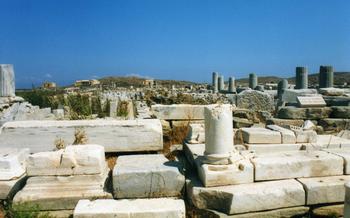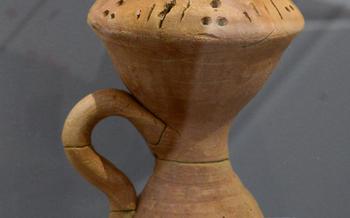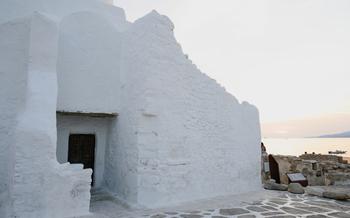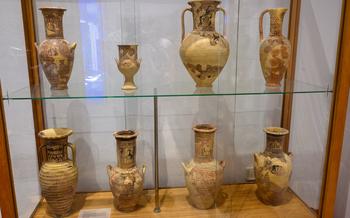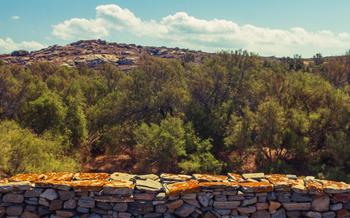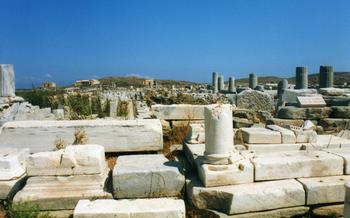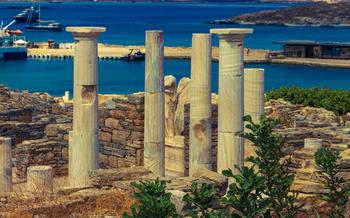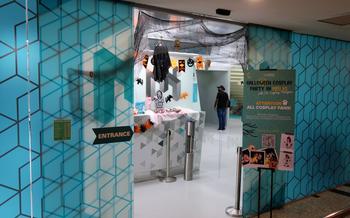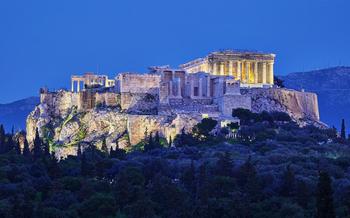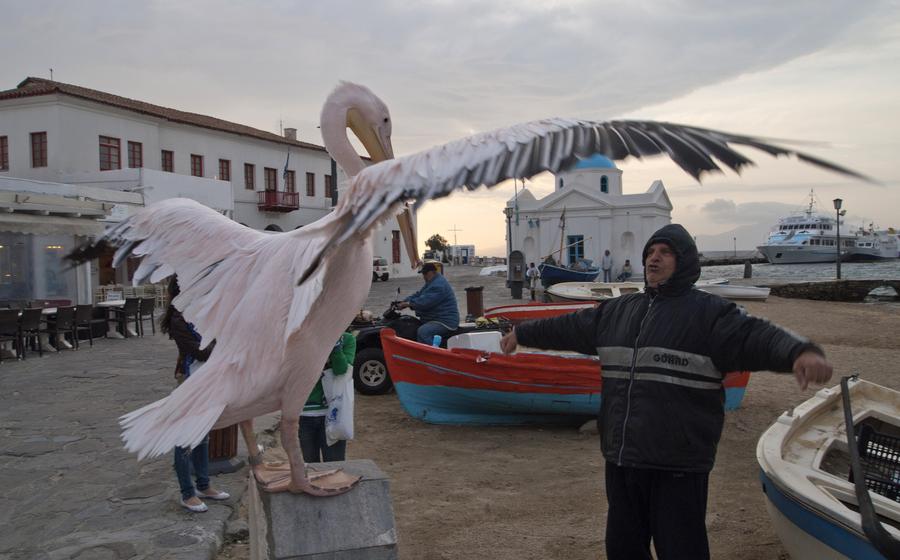
Ftelia Archeological Site
- The Antiquity of Ftelia Archaeological Site: A Journey Through Time
- Location and Accessibility
- Historical Overview
- Excavations and Discoveries
- Mycenaean Cemetery
- Hellenistic Tower: A Strategic Stronghold
- Roman Villa
- Religious Sanctuaries
- Everyday Life in Ftelia:
- Interactive Museum Exhibitions
- Panoramic Views and Landscapes
- Beaches and Swimming
- Hiking and Nature Trails
- Insider Tip: Unveiling the Hidden Treasures of Ftelia Archeological Site
The Antiquity of Ftelia Archaeological Site: A Journey Through Time
The Ftelia Archaeological Site is a treasure trove of ancient history, revealing the rich cultural heritage of Mykonos. Its historical significance dates back to the 3rd millennium BC during the Early Cycladic period, where evidence of human habitation and pottery production has been uncovered. Subsequent periods of occupation include the Mycenaean period (16th-11th century BC), where a vast cemetery was discovered, shedding light on burial customs and practices. The Hellenistic period (4th-1st century BC) saw the construction of a strategic tower for defense and control, while the Roman period (1st century BC-4th century AD) left behind the remains of a luxurious villa adorned with intricate mosaics and frescoes. Ongoing excavations continue to uncover new artifacts and insights into the diverse civilizations that once thrived on this site.
Location and Accessibility
The Ftelia Archaeological Site is conveniently located on the southern coast of Mykonos, approximately 5 kilometers (3 miles) from Mykonos Town. Its proximity to the island's main town makes it easily accessible for visitors. To reach the site, you can take a scenic drive or hop on a local bus that departs regularly from Mykonos Town. Once you arrive, ample parking is available near the entrance, ensuring a hassle-free visit.
Historical Overview
The Ftelia Archeological Site reveals a rich tapestry of historical periods, each leaving its distinct mark. During the Early Cycladic period (3rd millennium BC), the area was inhabited by a thriving community that engaged in farming and fishing. Their legacy lies in the unearthed pottery, tools, and figurines that provide glimpses into their daily lives.
In the Mycenaean period (16th-11th century BC), Ftelia flourished as a significant settlement and trading center. Excavations have uncovered an extensive cemetery with chamber tombs and pithos burials, offering valuable insights into Mycenaean burial customs and social hierarchy.
During the Hellenistic period (4th-1st century BC), Ftelia underwent significant transformations. The construction of a fortified tower and defensive walls indicates the site's strategic importance for controlling the surrounding region. The Hellenistic era also witnessed the construction of shrines and altars dedicated to various deities, reflecting the religious beliefs and practices of the time.
The Roman period (1st century BC-4th century AD) brought prosperity and opulence to Ftelia. A luxurious villa adorned with intricate mosaics and well-preserved frescoes stands as a testament to the wealth and lifestyle of the Roman landowners. Workshops and industrial activities, such as metalworking, pottery, and glass production, flourished during this period, contributing to the economic vitality of the site.
Excavations and Discoveries
The Ftelia Archaeological Site has been the subject of numerous archaeological missions and excavations over the years. These endeavors have unearthed a wealth of artifacts and pottery, shedding light on the site's rich history and significance. Among the notable discoveries are ceramic vessels, tools, weapons, jewelry, and figurines dating from different periods.
The unearthed pottery holds particular importance, providing valuable insights into the daily lives and cultural practices of Ftelia's inhabitants. The presence of imported pottery from other regions indicates extensive trade and cultural exchange with neighboring civilizations.
The ongoing research and studies conducted at Ftelia continue to contribute to our understanding of this ancient site. Archaeologists and historians collaborate to piece together the puzzle of Ftelia's past, using the unearthed artifacts and evidence to reconstruct the story of this once-thriving settlement.
Mycenaean Cemetery
At the Ftelia Archaeological Site, archaeologists have uncovered an extensive cemetery dating back to the Mycenaean period (16th-11th century BC). This discovery sheds light on the burial customs and rituals of this ancient civilization. The cemetery consists of chamber tombs, where multiple individuals were buried together, and pithos burials, where bodies were placed in large storage jars. Grave goods and offerings, such as pottery, jewelry, and weapons, were found alongside the deceased, providing insights into their social status and beliefs. The Ftelia cemetery offers a valuable glimpse into the lives and funerary practices of the Mycenaeans who inhabited this region.
Hellenistic Tower: A Strategic Stronghold
In the heart of Ftelia, stands a testament to the strategic importance of the site - the Hellenistic Tower. Constructed during the 4th century BC, this imposing structure served as a watchtower and a defensive fortification, safeguarding the settlement from potential threats. Perched atop a hill, the tower offered a panoramic view of the surrounding landscape, allowing its occupants to monitor seafaring activities and potential incursions.
The tower's design reflects a blend of defensive and architectural prowess. Its sturdy walls, constructed using local stone, provided a robust barrier against attacks. Intriguing architectural features, such as loopholes and arrow slits, enabled the defenders to effectively repel invaders while minimizing their own exposure. These well-thought-out defensive elements highlight the strategic significance of the tower and the sophisticated military architecture employed by the Hellenistic inhabitants of Ftelia.
The tower's placement atop the hill also served a tactical purpose, providing a commanding view of the surrounding terrain. This strategic positioning allowed for early detection of approaching vessels, facilitating timely responses and defensive preparations. The tower's presence instilled a sense of security and control among the inhabitants of Ftelia, ensuring their readiness to protect their settlement from potential threats.
The Hellenistic Tower, with its strategic location and defensive features, stands as a testament to the ingenuity and foresight of the ancient inhabitants of Ftelia. It offers a glimpse into the security measures implemented to safeguard the thriving settlement, showcasing the importance placed on defense and protection in ancient times.
Roman Villa
The Ftelia Archeological Site also boasts an impressive Roman villa, a testament to the prosperity and luxury enjoyed by the ancient inhabitants of the region. Excavations have revealed a sprawling villa adorned with intricate mosaics, showcasing the artistic prowess and opulence of the Roman era. The well-preserved frescoes and wall paintings offer a glimpse into the lives and tastes of the wealthy landowners who once resided here. The architectural layout of the villa, with its spacious rooms, courtyards, and amenities, provides insights into the domestic life and social customs of the Roman period.
Religious Sanctuaries
Ftelia was also a significant religious center in ancient times, with several shrines and altars dedicated to various deities. These sanctuaries provided a place for the local population to worship and make offerings to their gods. Archaeologists have uncovered evidence of these religious practices, including votive offerings such as pottery, figurines, and jewelry. These offerings were often placed at the shrines or altars as a way to honor the deity or to seek their favor.
The presence of religious sanctuaries at Ftelia suggests that the site was an important pilgrimage destination for people from across the region. It is likely that religious festivals and ceremonies were held at these sanctuaries, bringing together people from different communities to celebrate their shared beliefs and traditions. The discovery of these religious sanctuaries provides valuable insights into the spiritual and religious practices of the ancient inhabitants of Ftelia.
Everyday Life in Ftelia:
In ancient Ftelia, people went about their daily lives, much like we do today. They had homes, raised families, worked, and engaged in social activities. Archaeological evidence provides glimpses into their everyday lives and social organization.
Houses in Ftelia were constructed using local materials such as stone and mudbricks. They were typically small and simple, with one or two rooms. Domestic structures, such as kitchens and storage areas, were often located adjacent to the main house.
Water management was essential for survival in Ftelia. The inhabitants built cisterns and wells to collect and store rainwater. These water sources were vital for drinking, cooking, and irrigation.
Agriculture played a significant role in the economy of Ftelia. The fertile soil and temperate climate were suitable for growing various crops, including wheat, barley, and olives. Animal husbandry was also practiced, with sheep and goats being common livestock.
The people of Ftelia engaged in various social activities. They celebrated religious festivals, participated in athletic competitions, and enjoyed music and dance. Trade and commerce were also important aspects of daily life, as evidenced by the presence of workshops and imported goods.
Interactive Museum Exhibitions
The Ftelia Archaeological Site boasts an on-site museum that houses a fascinating array of artifacts unearthed during the excavations. Interactive displays and multimedia presentations bring the history of the site to life, offering visitors an immersive and engaging experience. Educational programs and guided tours are available, providing in-depth insights into the significance of the discoveries and the daily lives of the ancient inhabitants. The museum caters to visitors of all ages, ensuring that everyone can learn and appreciate the rich cultural heritage of Ftelia.
Panoramic Views and Landscapes
The Ftelia Archaeological Site offers breathtaking panoramic views of the Aegean Sea and Mykonos. The site is set on a hilltop, providing visitors with an elevated perspective that allows them to admire the stunning natural beauty of the island. The Aegean Sea stretches out to the horizon, with its deep blue waters and small, picturesque islands dotting the landscape. The surrounding hills and valleys add to the scenic beauty of the area, creating a diverse and captivating tapestry of colors and textures.
For photography enthusiasts, the Ftelia Archaeological Site is a paradise. The panoramic views provide ample opportunities to capture stunning shots of the sea, the hills, and the archaeological remains. The site is also a great place to simply relax and appreciate the tranquility of the surroundings. Away from the hustle and bustle of Mykonos Town, the Ftelia Archaeological Site offers a peaceful retreat where visitors can immerse themselves in the beauty of nature and the history of the island.
Beaches and Swimming
The Ftelia Archeological Site offers a unique opportunity to combine history and culture with a refreshing beach experience. Just a short walk from the ancient ruins, you will find yourself on the pristine shores of Ftelia Beach, renowned for its crystal-clear waters and golden sands. Whether you prefer swimming, sunbathing, or engaging in water sports, this beach has something for everyone.
Take a refreshing dip in the crystal-clear waters and soak up the Mediterranean sun on the soft sands. Enjoy a leisurely swim or try your hand at various water sports such as windsurfing, kitesurfing, and paddleboarding. The waves at Ftelia Beach are ideal for both beginners and experienced surfers, making it a popular spot for water sports enthusiasts.
After exploring the ancient site and indulging in beach activities, you can unwind at one of the beach bars or tavernas that dot the shoreline. Sip on a cool drink, savor delicious local cuisine, and soak in the stunning views of the Aegean Sea.
Hiking and Nature Trails
For those who enjoy outdoor activities, Ftelia offers a network of trails for hiking and nature walks. Explore the surrounding hills and countryside, discovering hidden coves and secluded spots. The trails wind through the Mediterranean flora and fauna, allowing visitors to appreciate the natural beauty of the area. Whether you're an experienced hiker or simply looking for a leisurely stroll, the trails at Ftelia provide a wonderful way to connect with nature and escape the hustle and bustle of Mykonos Town.
Insider Tip: Unveiling the Hidden Treasures of Ftelia Archeological Site
To fully immerse yourself in the ancient wonders of Ftelia, consider visiting during the off-season when the crowds are fewer, allowing you to explore at your own pace and soak in the tranquility of the site. Combine your visit with a refreshing day at the nearby Ftelia Beach, where you can bask in the sun, swim in the crystal-clear waters, and indulge in delectable cuisine at the charming beach bars and tavernas. To delve deeper into the site's rich history and uncover its hidden stories, take advantage of the guided tours offered by local experts. These knowledgeable guides will provide fascinating insights and anecdotes, bringing the ancient world to life before your eyes.
